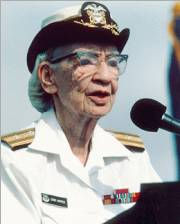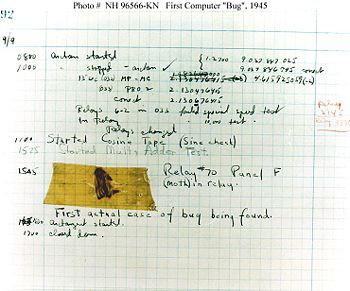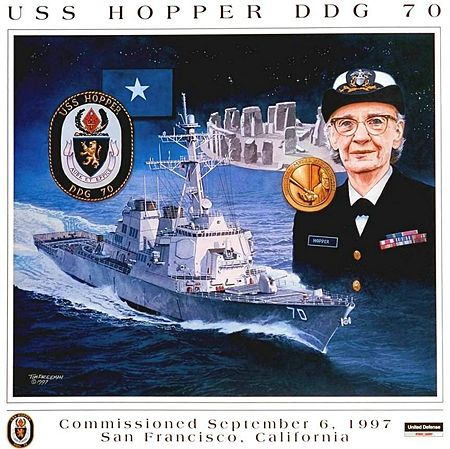Grace Murray Hopper
| This article may be deleted soon. | ||
|---|---|---|
Grace Murray Hopper (-1992) was a pioneering computer scientist and a rear admiral in the United States Navy. In the technical area, she is best known for the development of COBOL and other programming languages. Personally, she was admired as a leader, and mentor of creative thinking from high school to the Navy high command. A Burke-class destroyer of the U.S. Navy, USS Hopper (DDG-70) is named in her honor. Creative thinkingShe surrounded herself with reminders about thinking unconventionally. On her office wall was a clock that ran counterclockwise. When computer speeds broke into the microsecond range, she commanded her staff to "bring her a microsecond." Puzzled, she eventually explained she wanted to see one, and sent them off to cut pieces of wire that were the length that light traveled in one microsecond; she gave these out at her presentations. She climaxed that part of the presentation by having a strong member of her staff stumble onto the stage, carrying a large, heavy reel of wire: the distance light traveled in a millisecond. Computer scienceEarly computers and The BugIn her laboratory notebook, while working on the Harvard Mark II relay-based computer, she carefully documented the First Official Bug.
In 1988, the log, with the moth still taped by the entry, was in the Naval Surface Warfare Center Computer Museum at Dahlgren, Virginia.[1] COBOL and predecessorsWhile working for UNIVAC, she is credited with leading the development of the first English-like programming language, FLOW-MATIC. It was not the first programming language, but the first not using essentially mathematical notation, such as ALGOL or FORTRAN. IBM had put the FORTRAN scientific language in the public domain, and it became a de facto standard. Business programming, however, was quite another matter. FLOW-MATIC was UNIVAC-proprietary; IBM had its own approach that became snarled in legal matters, and there was a third competitor from the U.S. Air Force.[2] The COBOL project began with the intention of creating an open standard. In the Navy, she was known as "Grand Lady of Software," "Amazing Grace" and "Grandma Cobol". Rear Adm. Hopper retired from the Naval Reserve in January 1967, but was recalled to active duty in August 1967 by President Lyndon B. Johnson because of her much-needed expertise in applied computer science. Rear Adm. Hopper retired a second time in August 1986, becoming a "goodwill ambassador" for Digital Equipment Corporation. She died on Jan. 1, 1992. USS HopperThis is the first time since World War II, and only the second time in Naval history, that a warship has been named for a woman from the Navy’s own ranks.[3] Education
References
|
||


